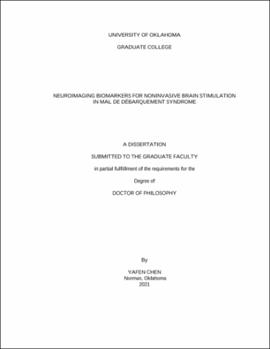| dc.description.abstract | This dissertation summarizes my work to identify biomarkers for neuromodulation treatment in Mal de Débarquement Syndrome (MdDS) using resting state EEG and fMRI. Biomarkers that are associated with the symptom changes after stimulations can potentially guide development and selection of effective treatment, therefore expediting the process of patients getting access to beneficial treatment. I have developed a data-driven method to extract and quantify the functional connectivity of resting-state brain networks as biomarkers. Through simultaneously acquired resting-state EEG and fMRI, I have identified response biomarkers at the network level across three different protocols (i.e., 10-Hz/1-Hz repetitive transcranial magnetic stimulation (rTMS), continuous theta burst stimulation (cTBS) and transcranial alternating current stimulation (tACS)). Specifically, my work have revealed that the visual network and the default mode network were clinically relevant to the symptom changes and potentially important indicators for optimizing the stimulation target.
I have also integrated simultaneous EEG and fMRI data to demonstrate the validity of EEG-network-based biomarkers. The EEG-informed fMRI has shown consistent synchronization with EEG networks in response to the repetitive transcranial magnetic stimulation. Furthermore, the entorhinal-cortex-seeded fMRI connectivity revealed that the stimulation-related changes in the left precuneus and cingulate gyrus have normalized the pathological differences in MdDS patients when compared with healthy controls. This part of analysis also has suggested the mechanism of noninvasive brain stimulation via modifying the connectivity patterns in disease-related networks.
Finally, I explored the feasibility of customizing the stimulation parameters in cTBS and tACS based on the imaging biomarkers. Through classifying targets into optimal vs. non-optimal, my analysis revealed that the transient EEG after a single, try-out administration of cTBS stimulation can signify the optimal stimulation targets. Furthermore, the response biomarkers showed distinct patterns that are sensitive to various tACS stimulation parameters, including frequencies and phases. Especially, the tACS based on the prior knowledge of individual alpha frequency is most effective in reducing symptoms, which again emphasized the importance of stimulation paradigm tailored to individuals.
Overall, the findings of my dissertation work have demonstrated the merit of multi-modal neuroimaging in noninvasive brain stimulation, in identifying the response biomarkers and understanding the mechanism of treatment. The integration of neuroimaging with stimulation will be able to optimize the individual treatment effect via personalizing the brain stimulation through a biomarker-based, closed-loop approach. | en_US |
